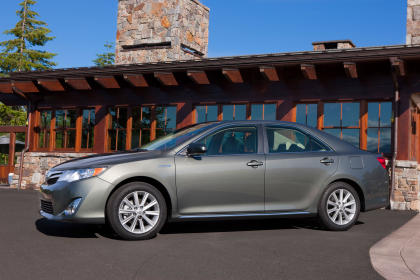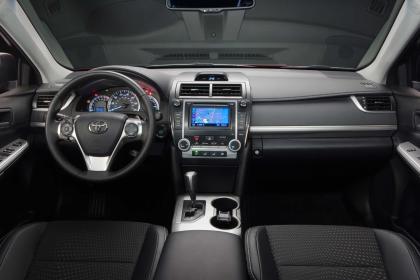First Drive: 2012 Toyota Camry
Toyota revamps its venerable family sedan and the hybrid model comes out the winner.

MORE AT YAHOO! AUTOS
For years, if you weren’t plugged into a rigid sense of buy-American, you had two choices when it came to a quality family sedan: the Honda Accord and the Toyota Camry. These days, the choice is not so cut and dried. The Koreans offer two excellent cars in the shape of the Hyundai Sonata and the Kia Optima. Volkswagen is taking a serious stab at the segment with an only-for-Americans Passat. GM and Ford have upped their game with recent iterations of the Fusion and Malibu. It’s as if the Japanese were caught flat-footed. The Accord leapt up a size class just as we started worrying about fuel economy, and the Camry? Well, let's say that Toyota had become rather complacent in its sales supremacy.
The last Camry featured soap-bar styling and a Play-Doh interior that did little to stir the soul. Not that a Camry’s ever been about soul-stirring, per se; but against a fresh crop of quality cars, it seemed dated. Unlike a somewhat subpar effort with the new Yaris, however, the latest iteration of Toyota’s mainstream sedan is a clear example of the company calling all hands to the deck in an attempt to woo back buyers. The result? If you’ve ever liked a Camry before, you’re almost certain to like this one.
That sounds like the sort of faint praise an enthusiast dismissive of the entire class of mid-size sedans would toss off and then suggest that you look into purchasing a vintage Lotus Elite II (a practical hatchback, after all!). But rather than damn the new Camry with faint praise, we’re praising it outright.
In fact, the only member of the new Camry line we’d have a hard time recommending is the sporty SE model ($23,760—$27,400). While it features the best steering of the bunch, the sport-tuned chassis feels out of character with the rest of the car, while the trunk spoiler and chunky 18-inch wheels resemble unfortunate tuner add-on bits. If we wanted a powerful, loaded Camry, we’d go with the V6 XLE ($30,605). The more luxury-oriented variant is still capable of sprinting from stoplight to stoplight or out on the highway — where it will comfortably cruise at extralegal speeds. The four-cylinder L ($22,715) and LE ($26,660) models are perfectly adequate for puttering around town and don’t feel underpowered; they’re classic examples of the family sedan as we’ve come to know it; simply good, solid cars that get 35 mpg on the highway and 25 in the city.

The best of the new Camrys, however, is the thoroughly revised hybrid. For many years, I was a hybrid skeptic. It wasn’t that Toyota’s Hybrid Synergy Drive system didn’t work — it’s that it lent an indirect feel to the vehicle. In something outré like the Prius, it was part of the charm and character of the car. Feeling the gas engine engage and disengage and going from regenerative braking into using the car’s discs for stopping power was all part of feeling good about saving fuel. But the new Camry hybrid barely feels like a hybrid at all. It has a welcome dollop of power over the four-cylinder examples, the regenerative braking is the most seamless we’ve encountered, and at low speeds or in traffic, you’ll be surprised how much time you spend running on electric power. The end result of all this tinkering is a pretty serious uptick in economy over the previous car. While the outgoing model achieved 31 mpg city and 35 mpg highway, the new hybrid gets 39 mpg on the open road and up to 43 mpg around town (41/38 city/hwy mpg for the XLE model).
To achieve over 40 mpg, Toyota resisted the urge to go bigger this time around. In fact, the new car’s external dimensions are exactly the same as the outgoing model’s, though the styling conspires to make the new model look slightly taller and narrower. Toyota refers to this as “Rational Tech-Dynamism,” a term we'd never heard before, either.

In the search for improved on-road dynamism and better economy, Toyota engineers put the new car on a weight-loss program, shaving a couple hundred pounds while judiciously increasing interior volume through the use of re-sculpted seats and a thinner headliner. The interior materials are a drastic step up, and while the company’s attempt to compare the new center stack to a mobile phone in form and function may be hyperbole, it all works well and doesn’t scream “rental car/fleet special” like the last edition. Up-level models are available with Toyota’s new Entune infotainment system, enabling the use of apps like OpenTable, Pandora and iheartradio while on the go.
The emphasis on weight-reduction and fine-tuning is a boon for handling dynamics. While nobody will ever confuse a Camry with a Porsche Panamera, that’s rather beside the point. I found the steering in the pre-production V6 XLE I drove to be maddeningly light at highway speeds, but the tiller in the four-cylinder and hybrid models all had a pleasant, 21st-century family-car feel. I found myself wishing that all of the cars’ electric power steering units had been programmed to respond like the sporty SE’s; the calibration felt just right.
Toyota needed a home run to continue competing in a segment it once owned. The L, LE, XLE and SE will all appeal to current Camry owners and undoubtedly bring some former owners and new buyers into the fold. The hybrid model, however, is currently in a class by itself. If it were my money — and as a Lotus Elite fanatic I rather can’t believe I’m saying this — the hybrid Camry would be the one I’d buy.


 Yahoo Autos
Yahoo Autos 
